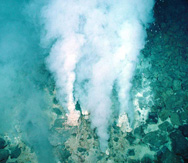Water at Ocean Vents Isn't Water---It's a Gas-Liquid Hybrid
 In the physical world, it sometimes seems that rules are made to be broken. Even the simplest principles can’t be taken at face value. Take water. A few molecules of H2O at normal atmospheric pressure are solid when below 32 degrees Fahrenheit, liquid between 32°F and 212°F, and gas when above 212°F. But this past August, when scientists reported observing water from a hydrothermal vent acting like a liquid and a gas simultaneously at 867°F, nature had thrown them for a loop. This was the first measurement of a phase transition–defying supercritical fluid.
In the physical world, it sometimes seems that rules are made to be broken. Even the simplest principles can’t be taken at face value. Take water. A few molecules of H2O at normal atmospheric pressure are solid when below 32 degrees Fahrenheit, liquid between 32°F and 212°F, and gas when above 212°F. But this past August, when scientists reported observing water from a hydrothermal vent acting like a liquid and a gas simultaneously at 867°F, nature had thrown them for a loop. This was the first measurement of a phase transition–defying supercritical fluid.It turns out the standard line about matter existing in three states—solid, liquid, and gas—is only part of the story. In extreme conditions—in this case, magma-heated water at an ocean depth of nearly 10,000 feet—things work a little differently. Any increase in temperature or pressure beyond a particular “critical point” (see the chart below) puts a material into the supercritical zone, “where the distinction between liquid and gas disappears,” says Virginia Tech polymer scientist Erdogan Kiran, who studies supercritical fluids.
These fluids can tell scientists a lot about the origins of materials and energy that fuel deep-vent ecosystems—providing clues about the minerals, metals, and heat that lie beneath the crust and that may have been key components to early life on the planet.
Although this is the first direct measurement of supercritical fluids in nature, they are believed to be a common (if difficult to observe) phenomenon on Earth and throughout the solar system. These fluids may drive the harsh atmosphere of Venus, are most likely found in the interiors of Uranus and Neptune, and are thought to exist on the seafloor of Jupiter’s moon Europa.
Re-created in a lab, supercritical fluids have many applications for manufacturing. Because fluids in this state interact differently with other materials, they can be used for processes such as decaffeinating coffee (getting rid of caffeine without cooking the beans). Polymers can also be modified in supercritical fluids for special applications such as drug delivery. These fluids may help wean us off fossil fuels by efficiently preparing biomass before it is made into ethanol. We may even give a boost to a carbon-free world by sequestering carbon dioxide as, you guessed it, a supercritical fluid.
You can return to the main Market News page, or press the Back button on your browser.

